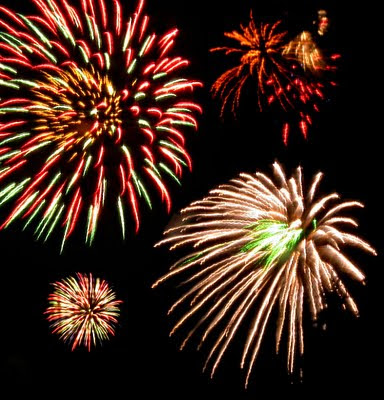 |
| Shot with Fuji FinePix HS10 set to "Fireworks." Photoshop for multiple images. |
In fact the picture I got wasn't just good but really great. Shooting from such a low angle, with a really wide angle lens, it might have been a 24mm, I captured not only the fireworks but some of the spectators sitting in chairs. I popped a little flash into the picture to add a little detail to the spectators. This was a story picture, a picture of the event, and not just a picture of fireworks.
With a fully manual DSLR camera:
 |
| Shot with a Canon SD10 compact point-and-shoot. |
Find a good vantage point for your shots. Ideally, you want to capture more than just a burst of colour in a night darkened sky. A picture that addresses the who, what, where, when and why of the event will be the stronger and far more interesting picture in years to come.
My shot of the girls watching the fireworks at a neighbourhood park was shot with a simple Canon SD10 point-and-shoot set to extended night exposure. I found an angle to silhouette the girls against the bright smoke from the fireworks. I was lucky enough to captured three bursting rockets in one shot. Love it!
Here in London, the fireworks are sometimes launched downtown over the forks of the Thames River. The obvious picture here is a huge, colourful burst or two with colourful reflections in the water below. If you can find and angle to show a few tall downtown buildings in the background, all the better.
With picture thinking out of the way:
- Ensure the camera is rock solid. Any movement during the exposure will ruin the picture. Obviously a good tripod is the easiest answer. Anything less can lead to frustration. Sometimes, in a pinch, you will be able to find a support for your camera at the event but this is not to be counted on.
- Choose a focal length to match your vision but be prepared to change this during the show. Wider is usually better than longer for capturing the context of the event. Telephotos will fill the frame with exploding fireworks.
- Set your focus at infinity. You will always be quite a distance from any major fireworks display.
- Set the aperture. I usually start with f/8 and stop down to f/11 if necessary. Remember, f/11 lets less light into the camera than f/8.
- Set the shutter speed to "B" for bulb or time exposure. With the shutter set to "B" you can depress the shutter button a moment after hearing the boom of the fireworks rocket launching. This way the shutter is open when the display starts. Keep the shutter button depressed until the burst begins to fade. This may be three or four seconds. If the bursts are coming quickly, one after another or overlapping, try holding the shutter open long enough to capture multiple bursts. If you find that you are causing the camera to move during the exposure, try using a cable release. With a good, solid tripod, a cable release is rarely necessary.
- Set the ISO. This does not have to be high. I have had good result shooting from ISO 100 to ISO 400. Fireworks are incredibly bright. High ISO settings are not necessary and may result in overexposed and/or grainy, images.
- Don't use your flash, in most cases. It will do nothing but possibly burnout the nearby foreground with overexposure. If your flash is built-in, turn it off. (This doesn't mean you can't experiment. You're shooting digital; You've got nothing to lose.)
- Check your images as you shoot, making sure the bursts are not out of frame. If you have a zoom lens, you can tweak the focal length if necessary.
To summarize:
- Find your vantage point.
- Mount your camera on tripod and frame your shot.
- Choose the focal length of your lens.
- Set the lens to infinity.
- Set the aperture - f/8 is a good start.
- Set the shutter speed - "B" or time exposure is best.
- Set the ISO. ISO100 often works. Do not use an ISO higher than 400.
- Turn off your flash, if necessary.
- Check your images as you work.
If you have a point-and-shoot, your options are limited and they change from camera to camera. You still need a good tripod but after that you may be at the mercy of your camera. My Canon SD10 had a long, nighttime setting that was excellent for shooting fireworks.
 |
| Dedicated fireworks setting: Fuji HS10 |
And if you don't mind altering reality a bit, you can always take your pictures into Photoshop or another photo enhancement program.
 |
| Red Rock, Ont.: Fireworks shot out a bathroom window. No sturdy tripod. |








